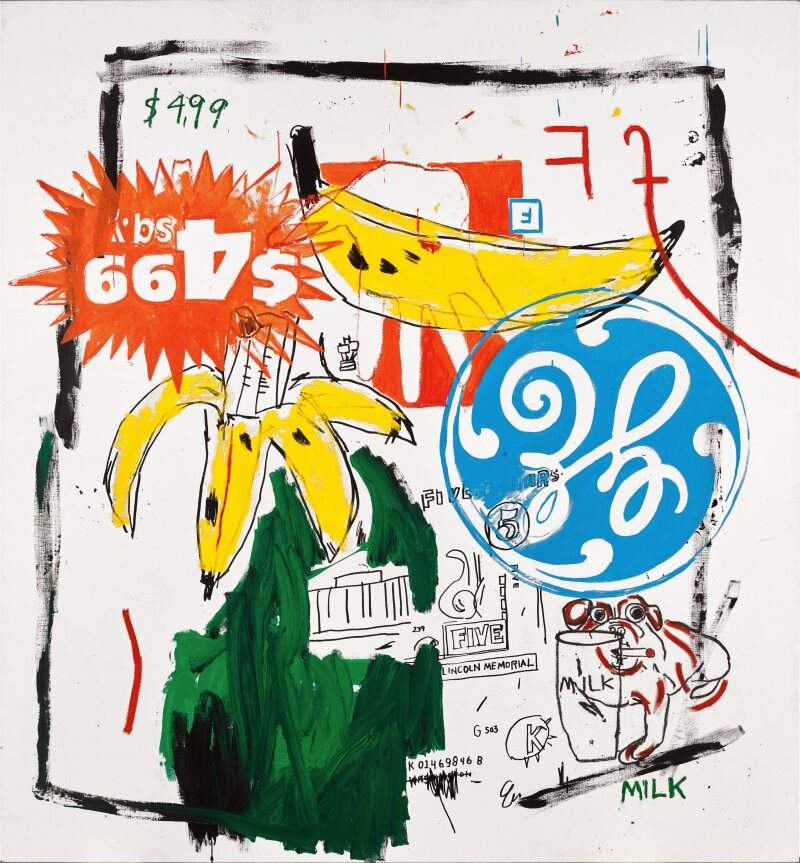




Private Sale
Andy Warhol and Jean-Michel Basquiat
Bananas
acrylic, silkscreen ink and oilstick on canvas
222.9 by 206.7 cm. 87¾ by 81⅜ in.
Executed in 1984-85.
Price upon request
Taxes not included
VAT and other taxes are not reflected in the listed pricing. Read more
Details
222.9 by 206.7 cm. 87¾ by 81⅜ in.
Provenance
Collection of Jean-Michel Basquiat
Galerie Bruno Bischofberger, Zurich
Private Collection
Phillips, New York, 23 June 2021, Lot 12
Acquired directly from the above sale by the present owner
Exhibition
Kassel, Museum Fridericianum; Munich, Museum Villa Stuck; Turin, Castello di Rivoli, Museo d'Arte Contemporanea, Collaborations - Warhol, Basquiat, Clemente, February 4, 1996 - January 19, 1997, p. 125, illustrated in colour, p. 61 and p. 114
Trieste, Civico Museo Revoltella Galleria d'Arte Moderna, Jean-Michel Basquiat, May 15 - September 15, 1999, p. 184, illustrated in colour, p. 185; (Francesco Clemente erroneously included as participant)
Madrid, Museo Nacional Centro de Arte Reina Sofía, Warhol, Basquiat, Clemente - Obras en Colaboración, February 5 - April 29, 2002, pp. 34, 36, 101, illustrated in colour, pp. 35, 80.
Vienna, Bank Austria Kunstforum, Warhol / Basquiat, October 16, 2013 - February 2, 2014, p. 50, illustrated in colour
Paris, Fondation Louis Vuitton; New York, Brant Foundation, Basquiat x Warhol: Painting Four Hands, April 2023 - January 2024, p.49, illustrated in colour
Literature
Jean-Louis Prat and Bruno Bischofberger, Jean-Michel Basquiat, Paris, 1996, p. 383, illustrated in colour
Luca Marenzi, et al., Jean-Michel Basquiat, Milan, 1999, p. 185, illustrated in colour
Jean-Louis Prat and Richard D. Marshall, Jean-Michel Basquiat, Paris, 2000, p. 66, illustrated in colour
Leonhard Emmerling, Jean-Michel Basquiat 1960-1988: The Explosive Force of the Streets, Cologne, 2015, p.67, illustrated in colour, p. 69
Hans Werner Holzwarth and Eleanor Nairne, Jean-Michel Basquiat and the Art of Storytelling, Cologne, 2018, pp. 394-395, illustrated in colour
Catalogue Note
Bursting with tenacious vibrancy and a sense of dramatic immediacy, Bananas is an extraordinary example of the collaboration period between Andy Warhol and Jean-Michel Basquiat. Executed between the years 1984 and 1985, Bananas is an accomplished product of their collaborative working environment, having formed a
friendship in the fall of 1982 after being introduced by Bruno Bischofberger. On first meeting, Warhol was already a legendary figure in the art world, known for his pop art and commercial imagery, while Basquiat was an emerging artist known for his raw, expressive style rooted in graffiti and neo-expressionism. During this first
encounter, an initial portrait session involving polaroids were being taken by Warhol. Basquiat excused himself after the session, only to return an hour later with a freshly painted reinterpretation of their photograph. Warhol was reportedly amazed by Basquiat's speed and skill. This painting, titled Dos Cabezas, marked the informal beginning of what would become a prolific and experimental collaboration.
Despite their stylistic differences, the two artists developed a close collaborative relationship based on mutual respect and a shared fascination with themes like consumerism, fame, and capitalism. They often worked together by building off each other's contributions - Warhol would start a piece with familiar logos or imagery, and Basquiat would add spontaneous, expressive marks, sometimes even defacing Warhol's work in playful ways. This back-and-forth process created artworks that combined Warhol's polished, iconic symbols with Basquiat's energetic, cryptic drawings and texts. The bright imagery of the banana featured in the present work, may well be interpreted as a private joke between the close collaborators, especially considering Basquiat's Brown Spots (Portrait of Andy Warhol as a Banana), created the same year for his debut solo exhibition at Mary Boone Gallery. The image of the banana was used repeatedly in Warhol's practice, with the artist obsessing over its symbolic and commercial ideology. The banana fit neatly into his idea of taking ordinary commercial representation and re-contextualizing it as fine art. However Warhol was also drawn to the sexual and subversive connotations that the image of the banana might suggest.
Warhol was able to use this object without being overtly explicit, yet alluding to sexual innuendos and challenging the rife conservative boundaries at the time. Art dealer Bruno Bischofberger, who represented both artists, once noted that Bananas was Basquiat's "secret favorite" of his collaborative works with Warhol. Basquiat initially kept the present work in his personal collection before eventually selling it to Bischofberger.
Warhol and Basquiat's partnership was more than just making art side-by-side; it was a creative dialogue that pushed both artists to experiment and take risks. Basquiat inspired Warhol to reconnect with painting and explore new techniques, while Warhol introduced Basquiat to screenprinting and the commercial art world. The culmination of the collaboration between the two artists resulted in an exhibition of 16 works at Tony Shafrazi Galley at the end of September 1985, organised by the gallerist who represented both artists - Bruno Bischofberger. The reviews of the exhibition were mostly negative, which Basquiat took very personally, subsequently breaking off all painting sessions at the Factory. Warhol, who was more resilient to bad press, was frustrated at Basquiat's reaction and thus ended their painting collaborations. However, Basquiat later revealed that even though their 'public' collaboration had ended, they continued working together secretly, driven by their enjoyment of their artistic exchange.
Bananas represents one of the most momentous partnerships in contemporary art, featuring the frequented consumerism markings of 'GH' and striking adverts of bargains highlighted by the large '$4.99' - painted with fevered energy by Warhol. Basquiat then inverts the canvas, scrawling his primitive paint and delicate line drawings throughout the canvas, balancing two crude bananas around Warhol's contribution, bringing the central composition to life. Warhol and Basquiat consistently returned to themes centered on consumerism and capitalism, with each artist's interventions enhancing rather than erasing the other's input.
Bananas stands as a testament to one of the most significant artistic collaborations in modern art history. Moving in independent synchronicity, Warhol and Basquiat worked in balance and cadence, producing a singular, harmonious creation that balances their unique voices.